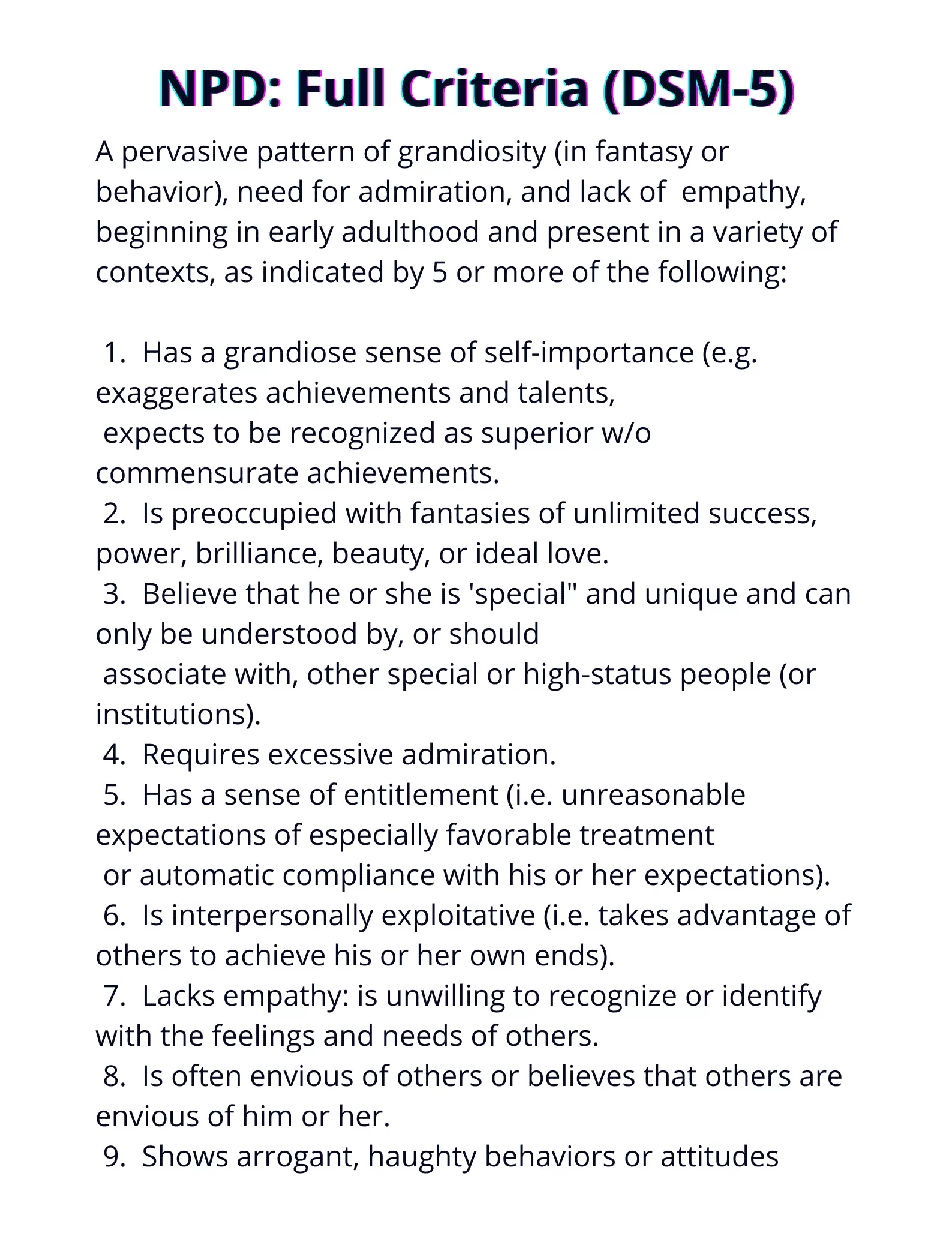Today's Sunday • 17 mins read
— By Dr. Sandip Roy.
Out of 20 psychological traits of a narcissist, two lie at the center: an inflated sense of self-importance and a lack of empathy for others.
Now, some of them are grandiose narcissists, the extreme ones who brag arrogantly, act like gods, and dismiss other people like they don’t matter. They are relatively easy to spot.
And then, there are the hidden, vulnerable narcissists. These less extreme types are also called covert narcissists, and their types do some weird things.
Whatever their type, narcissists always find time to worship their larger-than-life self-image. Self-worship makes them feel better, especially when others stop valuing them.
Glorifying themselves (and demeaning others) relieves their pain of being average, having failed, being ignored.
There’s more; read on.
20 Traits of A Narcissist: Narcissistic Behavior Red Flags
Twenty Signs of A Narcissist
1. 💼 Exploitation of Others
Any narcissist’s fundamental nature is to exploit others for selfish interests; they don’t know otherwise.
They see relationships as exchange-based transactions.
They think what others do for them is merely what they deserve. But what they do for others is a special gesture that deserves high gratitude and payback.
2. 🥊 Bullying Behavior
Narcissists are bullies who prey on the vulnerable. They can harass, insult, and even hurt others physically.
But their aggression is selective. They target only those they perceive as weak while being sycophantic and obsequious to those who hold power.
In a way, narcissists are fans of powerful narcissists but bullies to gentle people. This duality shows their need for dominance and also safety for their fragile self-worth.
3. 🚫 Disrespect for Boundaries
Narcissists have an inherent disregard for boundaries.
They almost take it as their right to step on others’ turf. It’s how they try people’s moral and tolerant boundaries.
They feel entitled to invade others’ privacy and personal space, often testing how far they can push others’ limits before facing consequences.
4. 🎮 Need for Control
Control is a central theme in narcissistic behavior.
Narcissists micromanage their surroundings and relationships. They can’t stand others making decisions for them.
This dictatorial behavior is driven by anxiety when they feel out of control. This need stems from their fragile self-esteem, which craves stability through dominance.
5. 👑 Strong Sense of Entitlement
Entitlement is when someone believes they deserve special treatment or recognition, even when they may not have done anything to deserve it.
Narcissists, by nature, possess an inflated sense of entitlement. They truly believe that they deserve to be treated as superior people.
This belief is often unshakeable, and it leads them to expect unquestioning compliance from others.
6. 💔 Lack of Empathy
Narcissists are emotionally detached. They have no genuine concern for other people’s feelings or pain.
More accurately, narcissists don’t feel emotional empathy but are often good at faking it.
They can show concern for your emotional distress after hurting you, but inside, they can’t feel true remorse or guilt for their acts.
7. 🌟 Belief in Superiority
Narcissists have an unwavering belief in their superiority.
They truly believe they are better than everyone else around them. These smug people feel they are more popular, talented, attractive, and even kinder and more generous than others.
Their one main regret, especially when they get old, is that the world didn’t give them enough value for their talent and greatness.
8. 📈 Inflated Sense of Self-Importance
Narcissists have an excessively high opinion of their worth and importance. To make this point, they brag about their achievements, skills, and abilities.
They are also arrogant. Because they will meet any challenge to their self-image of “importance” with defensiveness or rage.
9. 🎭 Overestimation of Abilities
This is the paradox: most of their self-belief is an overestimation.
Narcissists often overestimate their abilities and accomplishments. This creates a facade of competence that can be easily shattered by reality.
10. 👀 Condescending Attitude
Narcissists carry a condescending attitude, as if they are looking at you from a higher plane.
Their words and actions openly reflect their low opinion of others. But why do they think this way?
They have an innate need to feel superior. Belittling others is a way for them to elevate themselves and reinforce their self-image.
11. ⚔️ Arrogance and Hostility
Narcissists are inherently arrogant and hostile. This hostility serves to protect their fragile ego.
A reflection of this is that they find it almost impossible to apologize or admit fault.
12. 🚷 Denial of Responsibility
Narcissists refuse to take responsibility for their actions. Their default is to deflect blame onto others, avoiding accountability at all costs.
In extreme cases, they refuse to accept responsibility even when caught cheating or lying, blaming it on the person who charged them.
13. 🦈 Predatory Relationships
Narcissists maintain predatory relationships. They use people as tools to control and extract their supply.
They use their partners, family members, and romantic relationships to serve their own needs. Once these individuals no longer serve a purpose, the narcissist often discards them.
They also tend to associate with influential people to boost their own status and ego.
14. 🌊 Superficial Relationships
Narcissists maintain shallow relationships, lacking emotional depth.
Even if they don’t admit it, they know this nature of themselves. This superficiality leaves their loved ones feeling emotionally drained and unfulfilled.
15. 🪞 Fragile Self-Esteem
Beneath their grandiosity lies a fragile self-esteem that requires constant validation. This need for admiration is a driving force behind their behavior.
16. ⚠️ Sensitivity to Criticism
Narcissists are extremely sensitive to criticism.
They can’t handle even the mildest criticisms, even constructive feedback. They often react to any critique in a hostile way, as if it were an insult to their ego.
This sensitivity is rooted in their need to protect their inflated self-image.
17. 🧍♂️ Self-Centeredness
Narcissists are profoundly self-centered. They come first, every time.
Their actions and decisions revolve around their own desires and needs. Their self-centredness is blind to the impact of their actions on others.
18. 🎤 Attention Seeking
Narcissists seek constant attention and admiration from others, always wanting to be the center of focus.
This incessant need for praise often makes them hijack conversations to redirect focus onto themselves. This, again, comes from their need to feel elevated by being the center of admiration.
19. 🌌 Reality Distortion
Narcissists live in a fantasy world created by self-deception and magical thinking.
They distort reality to create an idealized version of their lives. It feeds their grandiosity. It also lets them avoid facing the painful truth of their low self-esteem.
20. 💔 Envy and Projection
Narcissists frequently project their insecurities onto others. This is known as narcissistic projection.
For one, they may believe that others envy them, while it’s actually they who harbor deep-seated envy for others.
Narcissistic projection serves as a defense mechanism to shield their fragile self-esteem.
How To Spot A Covert Narcissist?
While grandiose narcissists openly brag, you would likely notice these in a covert narcissist:
- They often humblebrag.
- They tend to fish for compliments or validation.
- They bring up their achievements when you share your wins with them.
- This person becomes restless or sulky if they don’t receive attention, praise, or special treatment.
- They are quick to go on the defensive when their ideas, opinions, or actions get criticized or challenged.
A Narcissist’s Language
Can you tell a narcissist from their language? This study suggests you can, as highly narcissistic people tend to:
- Use more words overall.
- Use more swear words (e.g., “damn”).
- Frequently employ auxiliary verbs (e.g., “will”).
- Show less agreement in their speech.
- Use more aggressive and disagreeable words, leading to poorer quality relationships with others.
It is not difficult to spot a grandiose narcissist in a group; they often exude an attitude of superiority and boast about their accomplishments, qualities, or possessions in a crowd-pleasing way.
In contrast, some psychopathic narcissists may give you a chilling, unblinking stare from a distance, known as the sociopathic stare, which signals that they want you under total control.
Is Trump A Narcissist?
When NYT’s Maureen Dowd and Patrick Healy talked about Donald Trump’s approach to power during his second term, they made comments on his narcissistic traits:

- Need for Admiration: Dowd said Trump wants people to worship him: “The language at the convention and in the inaugural speech was ratcheted up to be more like he’s a divine creature.” Adding that Trump wants elites to respect him: “He loves it. Because he always wanted the love of the elites, and he still does.”
- Desire for Control and Power: Dowd indicates Trump now exudes a sense of absolute power and control in contrast to his first term: “Trump was seen as a clown, as a dilemma by some in his first term, but now he’s a master and commander of the entire fleet.” While Healy says, “Trump’s hunger for being worshiped is so related to his conception of power.”
- Self-Centered Leadership Style: Dowd says Trump brought his ”monomaniacal” approach to governing, away from traditional governance: “Trump has subsumed the idea of governing with his personality. … It’s just about him and his id. That’s it. It’s not going to be governing in the way that we know it.”
- “Narcissistic Explosion”: Dowd says that when narcissists are given everything they want, it can lead to an extreme, unchecked display of narcissistic behavior. “The one thing you really don’t want to do with extreme narcissists is give them everything they want, give them all the attention they want, because then you are inviting a narcissistic explosion of unparalleled force, which is what I think we’re heading for.”
- Lack of Empathy: Dowd draws a parallel between Trump’s administration and the Greek gods: “The White House now is reminding me of the Greek gods because they were so cruel and capricious. Often what they did made no sense, and it was all totally narcissistic and selfish, and I think that’s the kind of administration we’re watching.”
- Vindictiveness and Resentment: Narcissists hold and settle grudges with revenge against those they see as disloyal or critical. “He never forgets a slight, holding grudges and seeking revenge on those who challenge him. … The ‘Here I am’ was like a promise and a threat that he is now fulfilling.”
- Manipulation of Fear: Patrick Healy says, “Trump has played so effectively on the fear that people have, people’s fears in America, on the economy, immigration.”
Dowd says, “Saturday Night Live” portrayed Trump as this relatable and charming character who has those over-the-top characteristics—brashness, self-importance, boastfulness. “It shows him as a blowhard, but in a way he comes across kind of cool.”
Why do narcissists believe they are larger than life?

Narcissists perceive and maintain a belief in a larger-than-life image of themselves because:
- They create and become obsessed with a godlike, perfect version of themselves. This self-worship serves as a compensation for their deep-seated feelings of insecurity, inadequacy, and low self-worth.
- The grandiose persona they project acts as a defense mechanism, a fragile facade designed to conceal their profound shame, self-loathing, and fears of being unlovable or ordinary.
- Their narcissistic traits (entitlement, lack of empathy, and need for excessive admiration) stem from an underlying sense of emptiness and a desperate attempt to construct an idealized self-image to protect their fragile egos.
- Beneath the arrogant, self-absorbed exterior lies a tormented individual, haunted by feelings of inferiority and intense envy of others.
- Their relentless pursuit of narcissistic supply (attention, power, and status) is a futile attempt to fill the void within, a black hole of insecurity that can never be satisfied.
- The more they strive to convince the world of their superiority and uniqueness, the more they reveal their tragic inability to love and accept their true, flawed selves.
Deep down, narcissists know how embarrassingly average and unspecial they are.
Researchers support it:
- Back and colleagues (2013) note that narcissists use self-enhancement or self-protection strategies to sustain the grandiose self, in their narcissistic admiration and rivalry concept (NARC).
- Morf and Rhodewalt (2001) explain Narcissism as the dynamic process of creating and maintaining a grandiose self.

How is narcissism diagnosed?
The DSM-5 requires a person to have at least five of the following to be diagnosed as Narcissistic Personality Disorder (NPD):

- A grandiose sense of entitlement, that is, exaggerates achievements and talents, and expects to be recognized as superior without commensurate achievements.
- A preoccupation with fantasies of unlimited success, power, brilliance, beauty, or ideal love.
- A belief that they are special and unique, and can only be understood by, or should associate with, other special or high-status people.
- A need for excessive admiration.
- A sense of entitlement, that is, unreasonable expectations of especially favorable treatment or automatic compliance with their expectations.
- Interpersonally exploitative behavior. They are someone who takes advantage of others to achieve their own ends.
- A lack of empathy, that is, a person who is unwilling to recognize or identify with the feelings and needs of others
- Envy of others or a belief that others are envious of him/her.
- A show of arrogant and haughty behaviors or attitudes.
NPD can only be diagnosed by a qualified mental health clinician.
NPD is a part of Cluster B personality (disorders marked by inappropriate and volatile emotionality, unpredictable behavior, and struggle to maintain relationships). Cluster B personality disorders:
- Antisocial personality disorder (ASPD)
- Borderline personality disorder (BPD)
- Narcissistic Personality Disorder (NPD)
- Histrionic personality disorder (HPD)
How many types of narcissists are there?
Many experts feel that narcissists can be of six types. However, their two main types are:
- Grandiose narcissists. Highly self-centered. Use a lot of “I, me, mine” statements. Can largely adapt to the general population. Raskin and Hall’s Narcissistic Personality Inventory (NPI) measures grandiose narcissism by asking people if they agree with statements like, “I am a special person” or “I am more capable than other people.” (Raskin & Terry, 1988).
- Vulnerable narcissists. Also called covert narcissists. Usually keep their self-centeredness “hidden.” Their vulnerability is often associated with various personal and social problems (Kaufman et al., 2020; Miller et al., 2011).
How common is NPD?
TNPD affects about 1 in 200 people.
- NPD has a global lifetime prevalence of 6.2%.
- NPD affects around 0.5 percent of US adults.
- 75% of those diagnosed with NPD are men.
- Narcissism appears in the early-20s to mid-20s.
- Once it sets in, it is typically lifelong and may get worse in middle or old age unless treated.
- Positive life events, such as new achievements, secure relationships, and manageable setbacks, can lead to a significant reduction in pathologic narcissism over time (Ronningstam et al., 1995).
Narcissism In Children & Adolescents
Narcissism is moderately heritable (Vernon & Villani, 2008).
- Children are born with narcissistic tendencies. Babies mostly do things to get food and love.
- Narcissistic tendencies usually fade as children grow up. However, some children may become more narcissistic during adolescence.
A 2015 study found that narcissism levels have been increasing among Western youth, and contributing to societal problems such as aggression and violence.
This study found that narcissism type was predicted by specific parenting styles:
- Parental overprotection (“helicopter parenting”) and parental overvaluation were associated with greater grandiose narcissism.
- While parental leniency was associated with more vulnerable narcissism.
The children seem to partly acquire narcissism by internalizing parents’ inflated views of them (e.g., “I am superior to others” and “I am entitled to privileges”).
High narcissism in young people can also contribute to depression, anxiety, low self-worth, suicide attempts, and poor-quality relationships (Narcissistic traits in young people, 2020).
History of Narcissism
- The concept of narcissism can be traced to the Greek myth of Narcissus.
- When the egoistic hunter Narcissus rejects Echo’s love, the Gods condemn him to fall in love with his own reflection. He sees his image in the water, but each time he tries to touch it, the waves would make it disappear. He withers away, transfixed, longing for his unreachable self-image.
- Psychologists came to identify traits of Narcissus as narcissism. In 1898, Havelock Ellis, a British medical doctor, was the first to classify narcissism as a mental disorder.
- Sigmund Freud wrote a famous essay on narcissism in 1914: On Narcissism. He suggested narcissism was a normal stage in child development but becomes a disorder when it occurs after puberty.
NPD vs. NPT
NPT is a milder form of NPD.
| Aspect | Narcissistic Personality Disorder (NPD) | Narcissistic Personality Traits (NPT) |
|---|---|---|
| Definition | A mental health diagnosis with pervasive traits impairing social, occupational, or other functioning areas. | Self-centeredness, need for praise, and lack of empathy, not severe enough to impair daily functioning. |
| Severity | Severe, with a noticeably negative impact on daily life and relationships. | Mild to moderate, does not typically affect daily functions or relationships significantly. |
| Diagnosis | Requires clinical evaluation and meets criteria in DSM-5 or ICD-10. | No formal diagnosis; traits are present but not at a clinical level. |
| Impact on Life | Causes substantial difficulties in social, occupational, and other important areas. | May cause occasional interpersonal issues but generally manageable. |
| Behavioral Patterns | Persistent grandiosity, excessive need for admiration, and profound lack of empathy. | May exhibit self-centered behavior and desire for admiration without the pervasive impact. |
| Empathy | Marked lack of empathy; difficulty recognizing or caring about others’ needs and feelings. | Reduced empathy but still capable of recognizing others’ needs and feelings to some extent. |
| Functioning | Often struggles to maintain healthy relationships and stable job performance. | Generally maintains functional relationships and job performance. |
| Treatment | Often requires psychotherapy, and sometimes medication, for management. | Traits can be addressed with self-awareness, personal development, and sometimes counseling. |
| Recognition of Issue | Often lacks insight into their condition; resistant to acknowledging the disorder. | May recognize their self-centered behavior and its impact, more open to self-improvement. |
Books on Narcissism
- The Narcissism Epidemic: Living in the Age of Entitlement (2009) by Twenge and Campbell
- Disarming the Narcissist: Surviving and Thriving with the Self-Absorbed (2014) by Wendy Behary
- The Narcissist Next Door: Understanding the Monster in Your Family, in Your Office (2014) by Kluger
- Should I Stay or Should I Go?: Surviving a Relationship with a Narcissist (2015) by Ramani Durvasula
- The Narcissist You Know: Defending Yourself Against Extreme Narcissists (2017) by Joseph Burgo
- The Narcissist’s Playbook: How to Identify, Disarm, and Protect Yourself (2019) by Dana Morningstar
- The Narcissist in Your Life: Recognizing the Patterns and Learning to Break Free (2019) by Julie Hall
- Narcissistic Mothers: How to Handle a Narcissistic Parent and Recover from CPTSD (2020) by Foster
Research On Narcissism
10 research papers on narcissism:
- The Dark Side of Leader Narcissism: The Relationship Between Leaders’ Narcissistic Rivalry and Abusive Supervision. Gauglitz & Schyns, 2022.
- Narcissism Today: What We Know and What We Need to Learn. Current Directions in Psychological Science. Miller & Back, 2021.
- The link between narcissism and aggression: A meta-analytic review. Kjærvik & Bushman, 2021.
- Factors influencing TikTok engagement behaviors in China: An examination of gratifications sought, narcissism, and the Big Five personality traits. Meng & Leung, 2021.
- Making CEO Narcissism Research Great: A Review and Meta-Analysis of CEO Narcissism. Cragun & Olsen, 2020.
- Collective Narcissism and Its Social Consequences: The Bad and the Ugly. de Zavala & Lantos, 2020.
- The “Why” and “How” of Narcissism: A Process Model of Narcissistic Status Pursuit. Grapsas & Brummelman, 2020.
- Narcissism and problematic social media use: A systematic literature review. Casale & Banchi, 2020.
- Raising Children With High Self‐Esteem (But Not Narcissism). Brummelman & Sedikides, 2020.
- Clinical Correlates of Vulnerable and Grandiose Narcissism: A Personality Perspective. Kaufman & B., Weiss, 2018.
Final Words
“Narcissists want positive feedback about themselves, and they actively manipulate others to solicit or coerce admiration from them. Accordingly, narcissism is thought to reflect a form of chronic interpersonal self-esteem regulation.” — Encyclopedia Britannica
Did you know that narcissists think they are more popular than their peers, but research shows they are actually less popular? Even if they initially get popularity, they eventually lose their status.
Don’t let a narcissist’s popular charm trap you. It is best to recognize this person from a distance and stay away.
√ Also Read: 10 Safest Ways To Trick A Narcissist Into Telling The Truth
√ Please share it with someone if you found this helpful.
